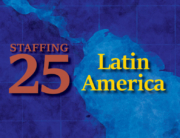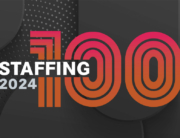Competition is fierce. Profit margins are thin. Staffing firms are exhausting all options to gain more strategic advantages and get ahead. For one, many are looking to outsourcing non-core business activities to operate more efficiently and lower costs. Another continuing trend is fueling growth via mergers or acquisitions. In this highly fragmented industry that is populated by regional and vertical niche players, M&A is prevalent. Substantial planning and key considerations are essential, whether owners are looking to buy, sell, expand or exit. Such M&A initiatives also uniquely correlate to the outsourcing concept. Then there’s the gig/cloud trend: Everyone is eager to see how it evolves in the year ahead.
This article shares insights from People 2.O — Rich Altus, president; and Judi Bell, COO. These experts address some trends and opportunities affecting the staffing industry, as well as how staffing firms can accelerate revenue growth, improve profitability, and diversify their revenue stream.
Q: There is much buzz in staffing about the “gig economy” and “human cloud” companies. What role does People 2.O play in that market?
Rich Altus: In the gig economy, companies are hiring from a plethora of skilled workers who don’t want fulltime employment. They may want to work on a particular project and then, when the engagement is done, go hike the Grand Canyon. A human cloud company is what I call a gig economy matchmaker. They want to remove an intermediary from the supply chain: the retained or contingent search company in the permanent placement world or the staffing company in the staffing world. They are focused on creating a great user hiring experience between the employee and the company. They are not looking to be the employer of record.
However, at the end of the day, someone has to make a determination about whether a gig is a W-2 engagement or a true independent contractor gig. Someone needs to onboard the person, consider the appropriate federal, state and local taxes, process the payroll, and bill the employers. This is where the People 2.O outsourcing model helps firms with efficiency and compliance.
Q: What opportunities do you see for staffing firms to grow faster and more efficiently?
Altus: Staffing executives need to be focused on their customers, on new customers, and on recruiting and retention. At People 2.O, we help them do that by giving them their time back. By effectively outsourcing infrastructure needs, such as IT, cyber security, internal risk management, and payroll, they can greatly improve productivity and focus on faster growth.
Q: What are some of staffing firms’ biggest challenges?
Altus: A challenge in the market overall is that the unemployment rate is so low. Then you couple that with local labor markets lacking certain skill sets. For example, rural America has moved to the cities, which affects light industrial. Employment in healthcare is rising, but there isn’t enough talent and experience in the workforce to meet the demand. And in food service and retail, we see that candidates lack workplace soft skills such as teamwork and interpersonal skills.
Then there’s the new presidential administration and the uncertainty surrounding what’s ahead. Staffing companies are going to have to keep an eye on what’s going to happen with the Affordable Care Act, for example. Plus, we may see more requirements for proper background checks to make sure employees have the right to work.
Q: Do you counsel staffing firm owners with an eye to acquisitions and other M&A activity? What are your typical recommendations?
Altus: Yes, we help our larger affiliates evaluate possible acquisitions. It starts with why they want to do it — to expand into new geographical markets, increase market share, capture new clients, acquire new management talent, diversify existing revenue or reduce competition in a market.
Once they are clear on why, we help them understand the process. You have to get to a Letter of Intent quickly. You can spend an awful lot of time having conversations, and then you realize that you’re willing to pay $6 million and the seller wants $10 million — and you’re pretty far apart.
Q: You recently acquired TFI Resources. How has that changed your service offerings? What does it mean for staffing firms?
Altus: We acquired TFI in February 2016, which enables us to offer employer of record status for recruiters. Recruiters can now take hold of their clients’ comprehensive workforce needs — that’s really important. This can help recruiters develop a recurring revenue stream, be able to go from temporary to permanent placement, and work with companies even when they are in a hiring freeze. People 2.O has been doing this service for staffing firms and now can do it for individual recruiters.
Q: From a back-office perspective, what challenges and opportunities do staffing companies face with the rise of freelancing and the gig economy?
Judi Bell: It’s a new ecosystem of temporary staffing initiatives and adapting to it is really an opportunity. Freelancing and the gig economy are geared toward recruitment, finding talent, and matching to positions. But once you have placed a person, what about payment? How does the transactional back-office piece get implemented? What about staying in compliance? This new ecosystem presents clients and recruiters with a new way to work, but backoffice operations are still essential.
Q: What should staffing firm owners understand before deciding to move forward with a back-office outsourcing solution?
Bell: I’d say they require a solid understanding of the future “day in the life” – what’s going to change and what will remain the same? They should make sure to engage core staff in planning and discussions. When those conversations with key staff members are neglected until after management has made a decision to outsource, there may be some resistance that can be disruptive.
Q: What should staffing firms consider with regard to outsourcing?
Bell: There are a number of things to consider. First, what’s holding you back from top and bottom line growth? Is it regulatory, reduced margins in your sector, recruitment, workers comp, your staff? Then seek outside counsel and do your research to determine if there are market partners who can do it better. Back-office operations is a good example; is your back office what differentiates you or will help you grow? Probably not.
Q: What metrics are used to measure the success of implementations?
Bell: It depends on the type of outsourcing you are doing. For example, we break our measures up into phases specific to our business model: the initial go-live phase, then a 45-day phase and a 90-day phase. Following implementation, we measure quarterly to assess satisfaction, progress, additional needs, etc.
In the go-live phase, we keep it really simple. Success is 100 percent accuracy on the first payroll and billing, as well as how well the staffing company’s core staff embraces the change. From there, we move to management’s expectations of what they want to change within 45 to 90 days. This may include special requirements for certain clients that didn’t come up in the initial planning, for example.
But if the temporary employees are happy, the client is happy and the core staff is happy, that’s our first key measurement.






